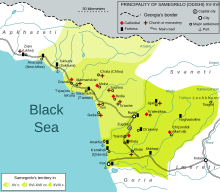Samurzakanians

Samurzakanians (Russian: Самурзаканцы, Georgian: სამურზაყანოელები, Abkhaz: Myrzaҟanaa) — a term for the inhabitants of Samurzakano[1] (modern Gali, Tkvarcheli and partially Ochamchire districts) that arose within the Abkhazian princedom[2] and got widely used in the official documents of Russian Empire in the 19th and early 20th centuries, in fact transforming it into an ethnonym.[2] In many ways, this identity was imposed from the government which was facilitated by the administrative policy of the Russian state.[2] Samurzakano was an ethnical contact zone located between the Enguri and Ghalidzga rivers,[3] where already in the 18th century a mixed Abkhaz-Georgian (Abkhaz-Megrelian) population was recorded.[3] Until the 1670s, the region was part of the Principality of Mingrelia, which then was invaded and annexed by the Principality of Abkhazia, causing massive influx of Abkhazian settlers to the newly conquered lands.[2][4][5] Compared to the 17th century when according to sources this area was inhabited mainly by Mingrelians, by the 19th century the ethnic composition of the population of Samurzakano had become more complex.[2] The region became bone of contention between the ruling houses of Abkhazia and Megrelia; while the locals were mostly adherents of Georgian Orthodoxy and bilingual in Abkhaz and Mingrelian.[6][7] Among the eastern Samurzakanians Mingrelian language was dominant, while Abkhazian predominated in the western part. It must be assumed that the majority of the Samurzakanians were Mingrelians, and the minority were Abkhazians.[1]
References
[edit]- ^ a b Cornell, Svante E. (2001). Small nations and great powers a study of ethnopolitical conflict in the Caucasus. Richmond, Surrey, England: Curzon. p. 144. ISBN 1-135-79669-6. OCLC 1162441747. Archived from the original on 6 June 2022. Retrieved 6 June 2022.
- ^ a b c d e Соловьева, Л. Субэтноним самурзаканцы: возникновение, история, современность. — 2010.
- ^ a b Lavrovskiĭ sbornik : materialy Sredneaziatsko-Kavkazskikh issledovaniĭ : ėtnologii︠a︡, istorii︠a︡, arkheologii︠a︡, kulʹturologii︠a︡. I︠U︡. I︠U︡. Karpov, I. V. Stasevich, Ю. Ю. Карпов, И. В. Стасевич, Lavrovskie chtenii︠a︡ (2007 : Muzeĭ antropologii i ėtnografii im. Petra Velikogo (Kunstkamera)), Лавровские чтения (2007 : Muzeĭ antropologii i ėtnografii im. Petra Velikogo (Kunstkamera)). Sankt-Peterburg: Muzeĭ antropologii i ėtnografii im. Petra Velikogo (Kunstkamera). 2006–2007. p. 75. ISBN 978-5-88431-150-3. OCLC 383773783. Archived from the original on 6 June 2022. Retrieved 6 June 2022.
{{cite book}}: CS1 maint: others (link) - ^ The making of modern Georgia, 1918–2012 : the first Georgian republic and its successors. Stephen F. Jones. New York. 2014. p. 488. ISBN 978-0-415-59238-3. OCLC 668197135. Archived from the original on 6 June 2022. Retrieved 6 June 2022.
{{cite book}}: CS1 maint: location missing publisher (link) CS1 maint: others (link) - ^ Transcaucasian boundaries. John F. R. Wright, Suzanne Goldenberg, Richard N. Schofield. London: UCL Press. 1996. p. 194. ISBN 0-203-21447-1. OCLC 252906502. Archived from the original on 11 July 2020. Retrieved 6 June 2022.
{{cite book}}: CS1 maint: others (link) - ^ Francis, Céline (2011). Conflict resolution and status : the case of Georgia and Abkhazia, 1989–2008. Brussels, Belgium. p. 102. ISBN 978-90-5487-899-5. OCLC 868969497. Archived from the original on 6 June 2022. Retrieved 6 June 2022.
{{cite book}}: CS1 maint: location missing publisher (link) - ^ The Abkhazians : a handbook = [Aphsuaa]. B. G. Hewitt. New York, N.Y.: St. Martin's Press. 1998. ISBN 0-312-21975-X. OCLC 39706880. Archived from the original on 6 June 2022. Retrieved 6 June 2022.
{{cite book}}: CS1 maint: others (link)
